This is a transclusion of the "History" section of the United States article, for easier viewing and editing. This is not a userspace draft.
Indigenous peoples
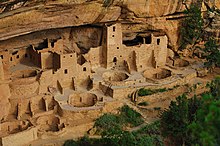
The first inhabitants of North America migrated from Siberia across the Bering land bridge at least 12,000 years ago; [2] [3] the Clovis culture, which appeared around 11,000 BC, is believed to be the first widespread culture in the Americas. [4] [5] Over time, indigenous North American cultures grew increasingly sophisticated, and some, such as the Mississippian culture, developed agriculture, architecture, and complex societies. [6] Indigenous peoples and cultures such as the Algonquian peoples, [7] Ancestral Puebloans, [8] and the Iroquois developed across the present-day United States. [9] Native population estimates of what is now the United States before the arrival of European immigrants range from around 500,000 [10] [11] to nearly 10 million. [11] [12]
European colonization
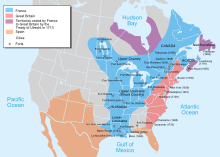
Christopher Columbus began exploring the Caribbean in 1492, leading to Spanish settlements in present-day Puerto Rico, Florida, and New Mexico. [13] [14] [15] France established its own settlements along the Mississippi River and Gulf of Mexico. [16] British colonization of the East Coast began with the Virginia Colony (1607) and Plymouth Colony (1620). [17] [18] The Mayflower Compact and the Fundamental Orders of Connecticut established precedents for representative self-governance and constitutionalism that would develop throughout the American colonies. [19] [20] While European settlers in what is now the United States experienced conflicts with Native Americans, they also engaged in trade, exchanging European tools for food and animal pelts. [21] [a] Relations ranged from close cooperation to warfare and massacres. The colonial authorities often pursued policies that forced Native Americans to adopt European lifestyles, including conversion to Christianity. [25] [26] Along the eastern seaboard, settlers trafficked African slaves through the Atlantic slave trade. [27]
The original Thirteen Colonies [b] that would later found the United States were administered by Great Britain, [28] and had local governments with elections open to most white male property owners. [29] [30] The colonial population grew rapidly, eclipsing Native American populations; [31] by the 1770s, the natural increase of the population was such that only a small minority of Americans had been born overseas. [32] The colonies' distance from Britain allowed for the development of self-governance, [33] and the First Great Awakening, a series of Christian revivals, fueled colonial interest in religious liberty. [34]
American Revolution and Revolutionary War

After winning the French and Indian War, Britain began to assert greater control over local colonial affairs, creating colonial political resistance; one of the primary colonial grievances was a denial of their rights as Englishmen, particularly the right to representation in the British government that taxed them. In 1774, the First Continental Congress met in Philadelphia, and passed a colonial boycott of British goods that proved effective. The British attempt to then disarm the colonists resulted in the 1775 Battles of Lexington and Concord, igniting the American Revolutionary War. At the Second Continental Congress, the colonies appointed George Washington commander-in-chief of the Continental Army and created a committee led by Thomas Jefferson to write the Declaration of Independence, adopted on July 4, 1776. [35] The political values of the American Revolution included liberty, inalienable individual rights; and the sovereignty of the people; [36] supporting republicanism and rejecting monarchy, aristocracy, and hereditary political power; virtue and faithfulness in the performance of civic duties; and vilification of corruption. [37] The Founding Fathers of the United States, which included George Washington, Benjamin Franklin, Alexander Hamilton, Thomas Jefferson, John Jay, James Madison, Thomas Paine, and John Adams, were inspired by Greco-Roman, Renaissance, and Age of Enlightenment philosophies and ideas. [38] [39]
After the British surrender at the siege of Yorktown in 1781, American sovereignty was internationally recognized by the Treaty of Paris (1783), through which the U.S. gained territory stretching west to the Mississippi River, north to present-day Canada, and south to Spanish Florida. [40] Ratified in 1781, the Articles of Confederation established a decentralized government that operated until 1789. [35] The Northwest Ordinance (1787) established the precedent by which the country's territory would expand with the admission of new states, rather than the expansion of existing states. [41] The U.S. Constitution was drafted at the 1787 Constitutional Convention to overcome the limitations of the Articles; it went into effect in 1789, creating a federation administered by three branches on the principle of checks and balances. [42] Washington was elected the country's first president under the Constitution, and the Bill of Rights was adopted in 1791 to allay concerns by skeptics of the more centralized government; [43] [44] his resignations first as commander-in-chief after the Revolution and later as president set a precedent followed by John Adams, establishing the peaceful transfer of power between rival parties. [45] [46]
Westward expansion
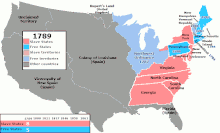
In the late 18th century, American settlers began to expand westward, some with a sense of manifest destiny. [47] The Louisiana Purchase (1803) from France nearly doubled the territory of the United States. [48] Lingering issues with Britain remained, leading to the War of 1812, which was fought to a draw. [49] Spain ceded Florida and its Gulf Coast territory in 1819. [50] The Missouri Compromise attempted to balance desires of northern states to prevent expansion of slavery in the country with those of southern states to expand it, admitting Missouri as a slave state and Maine as a free state and declared a policy of prohibiting slavery in the remaining Louisiana Purchase lands north of the 36°30′ parallel. [51] As Americans expanded further into land inhabited by Native Americans, the federal government often applied policies of Indian removal or assimilation. [52] [53] The infamous Trail of Tears (1830–1850) was a U.S. government policy that forcibly removed and displaced most Native Americans living east of the Mississippi River to lands far to the west. These and earlier organized displacements prompted a long series of American Indian Wars west of the Mississippi. [54] [55] The Republic of Texas was annexed in 1845, [56] and the 1846 Oregon Treaty led to U.S. control of the present-day American Northwest. [57] Victory in the Mexican–American War resulted in the 1848 Mexican Cession of California and much of the present-day American Southwest. [47] [58] The California Gold Rush of 1848–1849 spurred a huge migration of white settlers to the Pacific coast, leading to even more confrontations with Native populations. One of the most violent, the California genocide of thousands of Native inhabitants, lasted into the early 1870s, [59] [60] just as additional western territories and states were created. [61]
Civil War
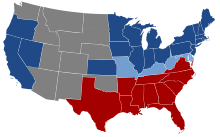
During the colonial period, slavery was legal in the American colonies, though the practice began to be significantly questioned during the American Revolution. [62] States in The North enacted abolition laws, [63] though support for slavery strengthened in Southern states, as inventions such as the cotton gin made the institution increasingly profitable for Southern elites. [64] [65] [66] This sectional conflict regarding slavery culminated in the American Civil War (1861–1865). [67] [68]
Eleven slave states seceded and formed the Confederate States of America, while the other states remained in the Union. [69] War broke out in April 1861 after the Confederacy bombarded Fort Sumter. [70] After the January 1863 Emancipation Proclamation, many freed slaves joined the Union Army. [71] The war began to turn in the Union's favor following the 1863 Siege of Vicksburg and Battle of Gettysburg, and the Confederacy surrendered in 1865 after the Union's victory in the Battle of Appomattox Court House. [72]
The Reconstruction era followed the war. After the assassination of President Abraham Lincoln, Reconstruction Amendments were passed to protect the rights of African Americans. National infrastructure, including transcontinental telegraph and railroads, spurred growth in the American frontier. [73]
Post-Civil War era
From 1865 through 1917 an unprecedented stream of immigrants arrived in the United States, including 24.4 million from Europe. [76] Most came through the port of New York City, and New York City and other large cities on the East Coast became home to large Jewish, Irish, and Italian populations, while many Germans and Central Europeans moved to the Midwest. At the same time, about one million French Canadians migrated from Quebec to New England. [77] During the Great Migration, millions of African Americans left the rural South for urban areas in the North. [78] Alaska was purchased from Russia in 1867. [79]
The Compromise of 1877 effectively ended Reconstruction and white supremacists took local control of Southern politics. [80] [81] African Americans endured a period of heightened, overt racism following Reconstruction, a time often called the nadir of American race relations. [82] [83] A series of Supreme Court decisions, including Plessy v. Ferguson, emptied the Fourteenth and Fifteenth Amendments of their force, allowing Jim Crow laws in the South to remain unchecked, sundown towns in the Midwest, and segregation in cities across the country, which would be reinforced by the policy of redlining later adopted by the federal Home Owners' Loan Corporation. [84]
An explosion of technological advancement accompanied by the exploitation of cheap immigrant labor [85] led to rapid economic development during the late 19th and early 20th centuries, allowing the United States to outpace England, France, and Germany combined. [86] [87] This fostered the amassing of power by a few prominent industrialists, largely by their formation of trusts and monopolies to prevent competition. [88] Tycoons led the nation's expansion in the railroad, petroleum, and steel industries. The United States emerged as a pioneer of the automotive industry. [89] These changes were accompanied by significant increases in economic inequality, slum conditions, and social unrest, creating the environment for labor unions to begin to flourish. [90] [91] [92] This period eventually ended with the advent of the Progressive Era, which was characterized by significant reforms. [93] [94]
Rise as a superpower

Pro-American elements in Hawaii overthrew the Hawaiian monarchy; the islands were annexed in 1898. Puerto Rico, Guam, and the Philippines were ceded by Spain following the Spanish–American War. [95] American Samoa was acquired by the United States in 1900 after the Second Samoan Civil War. [96] The U.S. Virgin Islands were purchased from Denmark in 1917. [97] The United States entered World War I alongside the Allies of World War I, helping to turn the tide against the Central Powers. [98] In 1920, a constitutional amendment granted nationwide women's suffrage. [99] During the 1920s and 30s, radio for mass communication and the invention of early television transformed communications nationwide. [100] The Wall Street Crash of 1929 triggered the Great Depression, which President Franklin D. Roosevelt responded to with New Deal social and economic policies. [101] [102]
At first neutral during World War II, the U.S. began supplying war materiel to the Allies of World War II in March 1941 and entered the war in December after the Empire of Japan's attack on Pearl Harbor. [103] [104] The U.S. developed the first nuclear weapons and used them against the Japanese cities of Hiroshima and Nagasaki in August 1945, ending the war. [105] [106] The United States was one of the " Four Policemen" who met to plan the postwar world, alongside the United Kingdom, Soviet Union, and China. [107] [108] The U.S. emerged relatively unscathed from the war, with even greater economic and international political influence. [109]
Cold War
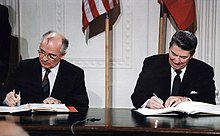
After World War II, the United States entered the Cold War, where geopolitical tensions between the U.S. and the Soviet Union led the two countries to dominate world affairs. [110] The U.S. engaged in regime change against governments perceived to be aligned with the Soviet Union, and competed in the Space Race, culminating in the first crewed Moon landing in 1969. [111] [112] [113] [114]
Domestically, the U.S. experienced economic growth, urbanization, and population growth following World War II. [115] The civil rights movement emerged, with Martin Luther King Jr. becoming a prominent leader in the early 1960s. [116] The Great Society plan of President Lyndon Johnson's administration resulted in groundbreaking and broad-reaching laws, policies and a constitutional amendment to counteract some of the worst effects of lingering institutional racism. [117] The counterculture movement in the U.S. brought significant social changes, including the liberalization of attitudes toward recreational drug use and sexuality. It also encouraged open defiance of the military draft (leading to the end of conscription in 1973) and wide opposition to U.S. intervention in Vietnam (with the U.S. totally withdrawing in 1975). [118] [119] [120] The societal shift in the roles of women partly resulted in large increases in female labor participation in the 1970s, and by 1985 the majority of women aged 16 and older were employed. [121] The late 1980s and early 1990s saw the collapse of the Warsaw Pact and the dissolution of the Soviet Union, which marked the end of the Cold War and solidified the U.S. as the world's sole superpower. [122] [123] [124] [125]
Contemporary

The 1990s saw the longest recorded economic expansion in American history, a dramatic decline in crime, and advances in technology, with the World Wide Web, the evolution of the Pentium microprocessor in accordance with Moore's law, rechargeable lithium-ion batteries, the first gene therapy trial, and cloning all emerging and being improved upon throughout the decade. The Human Genome Project was formally launched in 1990, while Nasdaq became the first stock market in the United States to trade online in 1998. [126] In 1991, an American-led international coalition of states expelled an Iraqi invasion force from Kuwait in the Gulf War. [127]
The September 11, 2001 attacks by the pan-Islamist militant organization al-Qaeda led to the war on terror and subsequent military interventions in Afghanistan and Iraq. [128] [129] The cultural impact of the attacks was profound and long-lasting.
The U.S. housing bubble culminated in 2007 with the Great Recession, the largest economic contraction since the Great Depression. [130] Coming to a head in the 2010s, political polarization increased as sociopolitical debates on cultural issues dominated politics. [131] This polarization was capitalized upon in the January 2021 Capitol attack, [132] when a mob of protesters entered the U.S. Capitol and attempted to prevent the peaceful transfer of power. [133]
- ^ "Cliff Palace" at Colorado Encyclopedia. Retrieved January 31, 2024
- ^ Erlandson, Rick & Vellanoweth 2008, p. 19.
- ^ Savage 2011, p. 55.
- ^ Waters & Stafford 2007, pp. 1122–1126.
- ^ Flannery 2015, pp. 173–185.
- ^ Lockard 2010, p. 315.
- ^ Smithsonian Institution—Handbook of North American Indians series: Handbook of North American Indians, Volume 15—Northeast. Bruce G. Trigger (volume editor). Washington, DC: Smithsonian Institution. 1978 References to Indian burning for the Eastern Algonquians, Virginia Algonquians, Northern Iroquois, Huron, Mahican, and Delaware Tribes and peoples.
- ^ Fagan 2016, p. 390.
- ^ Snow, Dean R. (1994). The Iroquois. Blackwell Publishers, Ltd. ISBN 978-1-55786-938-8. Retrieved July 16, 2010.
- ^ Thornton 1998, p. 34.
- ^ a b Perdue & Green 2005, p. 40.
- ^ Haines, Haines & Steckel 2000, p. 12.
- ^ Davis, Frederick T. (1932). "The Record of Ponce de Leon's Discovery of Florida, 1513". The QUARTERLY Periodical of THE FLORIDA HISTORICAL SOCIETY. XI (1): 5–6.
- ^ Florida Center for Instructional Technology (2002). "Pedro Menendez de Aviles Claims Florida for Spain". A Short History of Florida. University of South Florida.
- ^ "Not So Fast, Jamestown: St. Augustine Was Here First". NPR. February 28, 2015. Retrieved March 5, 2021.
- ^ Petto, Christine Marie (2007). When France Was King of Cartography: The Patronage and Production of Maps in Early Modern France. Lexington Books. p. 125. ISBN 978-0-7391-6247-7.
- ^ Seelye, James E. Jr.; Selby, Shawn (2018). Shaping North America: From Exploration to the American Revolution [3 volumes]. ABC-CLIO. p. 344. ISBN 978-1-4408-3669-5.
- ^ Bellah, Robert Neelly; Madsen, Richard; Sullivan, William M.; Swidler, Ann; Tipton, Steven M. (1985). Habits of the Heart: Individualism and Commitment in American Life. University of California Press. p. 220. ISBN 978-0-520-05388-5. OL 7708974M.
- ^ Remini 2007, pp. 2–3
- ^ Johnson 1997, pp. 26–30
- ^ Ripper, 2008 p. 6
- ^ Ehrenpreis, Jamie E.; Ehrenpreis, Eli D. (April 2022). "A Historical Perspective of Healthcare Disparity and Infectious Disease in the Native American Population". The American Journal of the Medical Sciences. 363 (4): 288–294. doi: 10.1016/j.amjms.2022.01.005. ISSN 0002-9629. PMC 8785365. PMID 35085528.
- ^ Joseph 2016, p. 590.
- ^ Stannard, 1993 p. xii
- ^ Ripper, 2008 p. 5
- ^ Calloway, 1998, p. 55
- ^ Thomas, Hugh (1997). The Slave Trade: The Story of the Atlantic Slave Trade: 1440–1870. Simon and Schuster. pp. 516. ISBN 0-684-83565-7.
- ^ Bilhartz, Terry D.; Elliott, Alan C. (2007). Currents in American History: A Brief History of the United States. M.E. Sharpe. ISBN 978-0-7656-1817-7.
- ^ Wood, Gordon S. (1998). The Creation of the American Republic, 1776–1787. UNC Press Books. p. 263. ISBN 978-0-8078-4723-7.
- ^ Ratcliffe, Donald (2013). "The Right to Vote and the Rise of Democracy, 1787–1828". Journal of the Early Republic. 33 (2): 220. doi: 10.1353/jer.2013.0033. S2CID 145135025.
- ^ Walton, 2009, pp. 38–39
- ^ Walton, 2009, p. 35
- ^ Otis, James (1763). The Rights of the British Colonies Asserted and Proved. ISBN 978-0-665-52678-7.
-
^ Foner, Eric (1998).
The Story of American Freedom (1st ed.). W.W. Norton. pp.
4–5.
ISBN
978-0-393-04665-6.
story of American freedom.
- ^ a b Fabian Young, Alfred; Nash, Gary B.; Raphael, Ray (2011). Revolutionary Founders: Rebels, Radicals, and Reformers in the Making of the Nation. Random House Digital. pp. 4–7. ISBN 978-0-307-27110-5.
- ^ Yick Wo vs. Hopkins, 118 U.S. 356, 370
- ^ Richard Buel, Securing the Revolution: Ideology in American Politics, 1789–1815 (1972)
- ^ Becker et al (2002), ch 1
- ^ "Republicanism". Stanford Encyclopedia of Philosophy. 19 June 2006. Retrieved 20 September 2022.
- ^ Miller, Hunter (ed.). "British-American Diplomacy: The Paris Peace Treaty of September 30, 1783". The Avalon Project at Yale Law School.
- ^ Shōsuke Satō, History of the land question in the United States, Johns Hopkins University, (1886), p. 352
- ^ Foner 2020, p. 524.
- ^ OpenStax 2014, § 8.1.
- ^ Foner 2020, pp. 538–540.
- ^ Boyer, 2007, pp. 192–193
- ^ OpenStax 2014, § 8.3.
- ^ a b Carlisle, Rodney P.; Golson, J. Geoffrey (2007). Manifest destiny and the expansion of America. Turning Points in History Series. Santa Barbara, Calif.: ABC-CLIO. p. 238. ISBN 978-1-85109-834-7. OCLC 659807062.
- ^ "Louisiana Purchase" (PDF). National Park Service. Retrieved March 1, 2011.
- ^ Wait, Eugene M. (1999). America and the War of 1812. Nova Publishers. p. 78. ISBN 978-1-56072-644-9.
- ^ Klose, Nelson; Jones, Robert F. (1994). United States History to 1877. Barron's Educational Series. p. 150. ISBN 978-0-8120-1834-9.
- ^ Hammond, John Craig (March 2019). "President, Planter, Politician: James Monroe, the Missouri Crisis, and the Politics of Slavery". Journal of American History. 105 (4): 843–867. doi: 10.1093/jahist/jaz002.
- ^ Frymer, Paul (2017). Building an American empire : the era of territorial and political expansion. Princeton, New Jersey: Princeton University Press. ISBN 978-1-4008-8535-0. OCLC 981954623.
- ^ Calloway, Colin G. (2019). First peoples : a documentary survey of American Indian history (6th ed.). Boston: Bedford/St. Martin's, Macmillan Learning. ISBN 978-1-319-10491-7. OCLC 1035393060.
- ^ Michno, Gregory (2003). Encyclopedia of Indian Wars: Western Battles and Skirmishes, 1850–1890. Mountain Press Publishing. ISBN 978-0-87842-468-9.
- ^ Billington, Ray Allen; Ridge, Martin (2001). Westward Expansion: A History of the American Frontier. UNM Press. p. 22. ISBN 978-0-8263-1981-4.
- ^ Morrison, Michael A. (April 28, 1997). Slavery and the American West: The Eclipse of Manifest Destiny and the Coming of the Civil War. University of North Carolina Press. pp. 13–21. ISBN 978-0-8078-4796-1.
- ^ Kemp, Roger L. (2010). Documents of American Democracy: A Collection of Essential Works. McFarland. p. 180. ISBN 978-0-7864-4210-2. Retrieved October 25, 2015.
- ^ McIlwraith, Thomas F.; Muller, Edward K. (2001). North America: The Historical Geography of a Changing Continent. Rowman & Littlefield. p. 61. ISBN 978-0-7425-0019-8. Retrieved October 25, 2015.
- ^ Wolf, Jessica. "Revealing the history of genocide against California's Native Americans". UCLA Newsroom. Retrieved July 8, 2018.
- ^ Madley, Benjamin (2016). An American Genocide: The United States and the California Indian Catastrophe, 1846-1873. Yale University Press. ISBN 9780300230697.
- ^ Rawls, James J. (1999). A Golden State: Mining and Economic Development in Gold Rush California. University of California Press. p. 20. ISBN 978-0-520-21771-3.
- ^ Walker Howe 2007, p. 52–54; Wright 2022.
- ^ Walker Howe 2007, p. 52–54; Rodriguez 2015, p. XXXIV; Wright 2022.
- ^ Walton, 2009, p. 43
- ^ Gordon, 2004, pp. 27,29
- ^ Walker Howe 2007, p. 478, 481–482, 587–588.
- ^ Murray, Stuart (2004). Atlas of American Military History. Infobase Publishing. p. 76. ISBN 978-1-4381-3025-5. Retrieved October 25, 2015. Lewis, Harold T. (2001). Christian Social Witness. Rowman & Littlefield. p. 53. ISBN 978-1-56101-188-9.
- ^ Woods, Michael E. (2012). "What Twenty-First-Century Historians Have Said about the Causes of Disunion: A Civil War Sesquicentennial Review of the Recent Literature". The Journal of American History. 99 (2). [Oxford University Press, Organization of American Historians]: 415–439. doi: 10.1093/jahist/jas272. ISSN 0021-8723. JSTOR 44306803. Retrieved April 29, 2023.
- ^ Silkenat, D. (2019). Raising the White Flag: How Surrender Defined the American Civil War. Civil War America. University of North Carolina Press. p. 25. ISBN 978-1-4696-4973-3. Retrieved April 29, 2023.
- ^ Vinovskis, Maris (1990). Toward A Social History of the American Civil War: Exploratory Essays. Cambridge; New York: Cambridge University Press. p. 4. ISBN 978-0-521-39559-5.
-
^
"The Fight for Equal Rights: Black Soldiers in the Civil War".
U.S. National Archives and Records Administration. August 15, 2016.
By the end of the Civil War, roughly 179,000 black men (10% of the Union Army) served as soldiers in the U.S. Army and another 19,000 served in the Navy.
- ^ Davis, Jefferson. A Short History of the Confederate States of America, 1890, 2010. ISBN 978-1-175-82358-8. Available free online as an ebook. Chapter LXXXVIII, "Re-establishment of the Union by force", p. 503. Retrieved March 14, 2012.
- ^ Black, Jeremy (2011). Fighting for America: The Struggle for Mastery in North America, 1519–1871. Indiana University Press. p. 275. ISBN 978-0-253-35660-4.
- ^ Price, Marie; Benton-Short, Lisa (2008). Migrants to the Metropolis: The Rise of Immigrant Gateway Cities. Syracuse University Press. p. 51. ISBN 978-0-8156-3186-6.
- ^ "Overview + History | Ellis Island". Statue of Liberty & Ellis Island. March 4, 2020. Retrieved September 10, 2021.
- ^ U.S. Bureau of the Census, Historical Statistics of the United States (1976) series C89-C119, pp 105–9
- ^ Stephan Thernstrom, ed., Harvard Encyclopedia of American Ethnic Groups (1980) covers the history of all the main groups
- ^ "The Great Migration (1910–1970)". National Archives. May 20, 2021.
- ^ "Purchase of Alaska, 1867". Office of the Historian. U.S. Department of State. Retrieved December 23, 2014.
- ^ Woodward, C. Vann (1991). Reunion and Reaction: The Compromise of 1877 and the End of Reconstruction. United Kingdom: Oxford University Press.
- ^ Drew Gilpin Faust; Eric Foner; Clarence E. Walker. "White Southern Responses to Black Emancipation". American Experience.
- ^ Trelease, Allen W. (1979). White Terror: The Ku Klux Klan Conspiracy and Southern Reconstruction. New York: Harper & Row. ISBN 0-313-21168-X.
- ^ Shearer Davis Bowman (1993). Masters and Lords: Mid-19th-Century U.S. Planters and Prussian Junkers. Oxford UP. p. 221. ISBN 978-0-19-536394-4.
- ^ Ware, Leland (February 2021). "Plessy's Legacy: The Government's Role in the Development and Perpetuation of Segregated Neighborhoods". RSF: The Russell Sage Foundation Journal of the Social Sciences. 7 (1): 92–109. doi: 10.7758/rsf.2021.7.1.06. S2CID 231929202.
- ^ Hirschman, Charles; Mogford, Elizabeth (1 December 2009). "Immigration and the American Industrial Revolution From 1880 to 1920". Social Science Research. 38 (4): 897–920. doi: 10.1016/j.ssresearch.2009.04.001. ISSN 0049-089X. PMC 2760060. PMID 20160966.
- ^ Carson, Thomas; Bonk, Mary (1999). "Industrial Revolution". Gale Encyclopedia of U.S. Economic History. Gale.
- ^ Riggs, Thomas (2015). Gale Encyclopedia of U.S. Economic History Vol. 3 (2 ed.). Gale. p. 1179.
- ^ Dole, Charles F. (1907). "The Ethics of Speculation". The Atlantic Monthly. C (December 1907): 812–818.
- ^ The Pit Boss (February 26, 2021). "The Pit Stop: The American Automotive Industry Is Packed With History". Rumble On. Retrieved December 5, 2021.
- ^ Tindall, George Brown and Shi, David E. (2012). America: A Narrative History (Brief Ninth Edition) (Vol. 2). W. W. Norton & Company. ISBN 978-0-393-91267-8 p. 589
- ^ Zinn, 2005, pp. 321–357
- ^ Fraser, Steve (2015). The Age of Acquiescence: The Life and Death of American Resistance to Organized Wealth and Power. Little, Brown and Company. p. 66. ISBN 978-0-316-18543-1.
- ^ Aldrich, Mark. Safety First: Technology, Labor and Business in the Building of Work Safety, 1870-1939. Baltimore: Johns Hopkins University Press, 1997. ISBN 0-8018-5405-9
- ^ "Progressive Era to New Era, 1900-1929 | U.S. History Primary Source Timeline | Classroom Materials at the Library of Congress | Library of Congress". Library of Congress, Washington, D.C. 20540 USA. Retrieved 11 November 2023.
- ^ "The Spanish–American War, 1898". Office of the Historian. U.S. Department of State. Retrieved December 24, 2014.
- ^ Ryden, George Herbert. The Foreign Policy of the United States in Relation to Samoa. New York: Octagon Books, 1975.
- ^ "Virgin Islands History". Vinow.com. Retrieved January 5, 2018.
- ^ McDuffie, Jerome; Piggrem, Gary Wayne; Woodworth, Steven E. (2005). U.S. History Super Review. Piscataway, NJ: Research & Education Association. p. 418. ISBN 978-0-7386-0070-3.
- ^ Larson, Elizabeth C.; Meltvedt, Kristi R. (2021). "Women's suffrage: fact sheet". CRS Reports (Library of Congress. Congressional Research Service). Report / Congressional Research Service. Retrieved August 9, 2023.
- ^ Winchester 2013, pp. 410–411.
- ^ Axinn, June; Stern, Mark J. (2007). Social Welfare: A History of the American Response to Need (7th ed.). Boston: Allyn & Bacon. ISBN 978-0-205-52215-6.
- ^ James Noble Gregory (1991). American Exodus: The Dust Bowl Migration and Okie Culture in California. Oxford University Press. ISBN 978-0-19-507136-8. Retrieved October 25, 2015. "Mass Exodus From the Plains". American Experience. WGBH Educational Foundation. 2013. Retrieved October 5, 2014. Fanslow, Robin A. (April 6, 1997). "The Migrant Experience". American Folklore Center. Library of Congress. Retrieved October 5, 2014. Stein, Walter J. (1973). California and the Dust Bowl Migration. Greenwood Press. ISBN 978-0-8371-6267-6. Retrieved October 25, 2015.
- ^ The official WRA record from 1946 states that it was 120,000 people. See War Relocation Authority (1946). The Evacuated People: A Quantitative Study. p. 8. This number does not include people held in other camps such as those run by the DoJ or U.S. Army. Other sources may give numbers slightly more or less than 120,000.
- ^ Yamasaki, Mitch. "Pearl Harbor and America's Entry into World War II: A Documentary History" (PDF). World War II Internment in Hawaii. Archived from the original (PDF) on December 13, 2014. Retrieved January 14, 2015.
- ^ "Why did Japan surrender in World War II?". The Japan Times. Retrieved February 8, 2017.
- ^ Pacific War Research Society (2006). Japan's Longest Day. New York: Oxford University Press. ISBN 978-4-7700-2887-7.
- ^ Hoopes & Brinkley 1997, p. 100.
- ^ Gaddis 1972, p. 25.
- ^ Kennedy, Paul (1989). The Rise and Fall of the Great Powers. New York: Vintage. p. 358. ISBN 978-0-679-72019-5
- ^ Sempa, Francis (12 July 2017). Geopolitics: From the Cold War to the 21st Century. Routledge. ISBN 978-1-351-51768-3.
- ^ Blakemore, Erin (March 22, 2019). "What was the Cold War?". National Geographic. Archived from the original on April 1, 2019. Retrieved August 28, 2020.
- ^ Mark Kramer, "The Soviet Bloc and the Cold War in Europe," in Larresm, Klaus, ed. (2014). A Companion to Europe Since 1945. Wiley. p. 79. ISBN 978-1-118-89024-0.
- ^ Blakeley, 2009, p. 92
- ^ Collins, Michael (1988). Liftoff: The Story of America's Adventure in Space. New York: Grove Press. ISBN 978-0-8021-1011-4.
- ^ Winchester 2013, pp. 305–308.
- ^ "The Civil Rights Movement". PBS. Retrieved January 5, 2019.
- ^ Brinkley, Alan (January 24, 1991). "Great Society". In Eric Foner; John Arthur Garraty (eds.). The Reader's Companion to American History. Houghton Mifflin Books. p. 472. ISBN 0-395-51372-3.
- ^ Svetlana Ter-Grigoryan (February 12, 2022). "The Sexual Revolution Origins and Impact". study.com. Retrieved April 27, 2023.
- ^ Levy, Daniel (January 19, 2018). "Behind the Protests Against the Vietnam War in 1968". Time. Retrieved May 5, 2021.
-
^
"Playboy: American Magazine".
Encyclopædia Britannica. August 25, 2022. Retrieved February 2, 2023.
...the so-called sexual revolution in the United States in the 1960s, marked by greatly more permissive attitudes toward sexual interest and activity than had been prevalent in earlier generations.
- ^ "Women in the Labor Force: A Databook" (PDF). U.S. Bureau of Labor Statistics. 2013. p. 11. Retrieved March 21, 2014.
- ^ Gaĭdar, E.T. (2007). Collapse of an Empire: Lessons for Modern Russia. Washington, D.C.: Brookings Institution Press. pp. 190–205. ISBN 978-0-8157-3114-6.
- ^ Howell, Buddy Wayne (2006). The Rhetoric of Presidential Summit Diplomacy: Ronald Reagan and the U.S.-Soviet Summits, 1985–1988. Texas A&M University. p. 352. ISBN 978-0-549-41658-6.
- ^ Kissinger, Henry (2011). Diplomacy. Simon & Schuster. pp. 781–784. ISBN 978-1-4391-2631-8. Retrieved October 25, 2015. Mann, James (2009). The Rebellion of Ronald Reagan: A History of the End of the Cold War. Penguin. p. 432. ISBN 978-1-4406-8639-9.
- ^ Hayes, 2009
- ^ CFI Team. "NASDAQ". Corporate Finance Institute. Archived from the original on 2023-12-11. Retrieved 2023-12-11.
- ^ Holsti, Ole R. (2011-11-07). "The United States and Iraq before the Iraq War". American Public Opinion on the Iraq War. University of Michigan Press. p. 20. ISBN 978-0-472-03480-2.
- ^ Walsh, Kenneth T. (December 9, 2008). "The 'War on Terror' Is Critical to President George W. Bush's Legacy". U.S. News & World Report. Retrieved March 6, 2013. Atkins, Stephen E. (2011). The 9/11 Encyclopedia: Second Edition. ABC-CLIO. p. 872. ISBN 978-1-59884-921-9. Retrieved October 25, 2015.
- ^ Wong, Edward (February 15, 2008). "Overview: The Iraq War". The New York Times. Retrieved March 7, 2013. Johnson, James Turner (2005). The War to Oust Saddam Hussein: Just War and the New Face of Conflict. Rowman & Littlefield. p. 159. ISBN 978-0-7425-4956-2. Retrieved October 25, 2015. Durando, Jessica; Green, Shannon Rae (December 21, 2011). "Timeline: Key moments in the Iraq War". USA Today. Associated Press. Archived from the original on September 4, 2020. Retrieved March 7, 2013.
- ^ Hilsenrath, Jon; Ng, Serena; Paletta, Damian (September 18, 2008). "Worst Crisis Since '30s, With No End Yet in Sight". The Wall Street Journal. ISSN 1042-9840. OCLC 781541372. Archived from the original on December 25, 2014. Retrieved July 28, 2023.
- ^ Hamid, Shadi (2022-01-08). "The Forever Culture War". The Atlantic. Retrieved 2023-10-01.
-
^ Duignan, Brian (2021-08-04).
"January 6 U.S. Capitol attack".
Encyclopædia Britannica.
Archived from the original on 2023-01-17. Retrieved 2021-09-22.
Because its object was to prevent a legitimate president-elect from assuming office, the attack was widely regarded as an insurrection or attempted coup d'état.
- ^ Rutenberg, Jim; Becker, Jo; Lipton, Eric; Haberman, Maggie; Martin, Jonathan; Rosenberg, Matthew; Schmidt, Michael S. (31 January 2021). "77 Days: Trump's Campaign to Subvert the Election". The New York Times. Archived from the original on 2022-06-18.
Cite error: There are <ref group=lower-alpha> tags or {{efn}} templates on this page, but the references will not show without a {{reflist|group=lower-alpha}} template or {{notelist}} template (see the
help page).